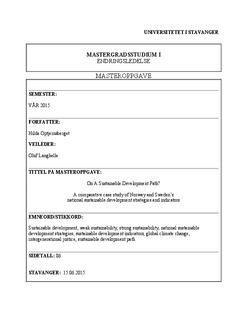| dc.contributor.author | Optjernsberget, Hilde | |
| dc.date.accessioned | 2015-10-12T08:17:03Z | |
| dc.date.available | 2015-10-12T08:17:03Z | |
| dc.date.issued | 2015-06 | |
| dc.identifier.uri | http://hdl.handle.net/11250/2353980 | |
| dc.description | Master's thesis in Change management | nb_NO |
| dc.description.abstract | This thesis explores the phenomenon of national sustainable development strategies by
comparing such strategies for Norway and Sweden. Based on the operationalization of their
strategies into goals and indicators, it is possible to reflect upon whether Norway and Sweden are
on a sustainable development path. The background for the thesis is the threat of climate change
on the planet and its boundaries that may cause irreversible damages to future generations. The
starting point is the concept of sustainable development by the World Commission on
Environment and Development (WCED) in 1987 (p. 8). The Rio-Initiative in 1992 addressed the
climate threat among other sustainable development issues in Agenda 21 by asking nations to
develop national sustainable development strategies (UNCED, 1992). Such strategies and
processes were studied by Dalal-Clayton (1996) in Getting to Grips with Green Plans. His
framework of key lessons and guiding principles is the foundation for this thesis. The first
Norwegian and Swedish plans are part of his study. His findings produced a basis, which are
useful for the exploration of the most recent strategies.
Three research questions are defined, and the thesis is divided into corresponding parts. The
research questions are seen in the light of two broad paradigms, weak sustainability and strong
sustainability (Neumayer, 2013). The research strategy for the thesis is exploratory and abductive
with a qualitative approach using mostly secondary data on the two strategies and statistics on the
indicators studied. The methods used are discourse and document analysis. The primary data
from a few key informants provide background information and verify some of the findings. The
first part finds that the Norwegian and Swedish strategies primarily have a weak understanding of
sustainability. The second part explores the operationalization of strategies into goals and indicators for the two
main themes of the thesis, namely climate change and intergenerational justice. The framework
of Organization for Economic Co-operation and Development (OECD) and the Stiglitz
commission form the basis for the discussion of indicator approaches chosen by Norway and
Sweden. Norway has chosen a capital approach with sub-themes to account for the economic,
social and environmental dimensions of sustainable development. The main indicator for
intergenerational justice in the Norwegian strategy is national wealth and non-declining welfare over time (St.prp. nr. 1 (2007-2008), 2007). On the other hand, the Swedish strategy has chosen
an overall environmental goal for sustainable development where 16 environmental quality
objectives represent intergenerational justice (Comm. 2005/06:126, 2005). The statistical data on
the indicators show that Norway and Sweden will probably not meet their targets for climate
mitigation by 2020. It may be questioned whether they are taking their burden of climate
mitigation and are sustainable in the long run.
The third part of the thesis discusses the data for climate change and intergenerational justice
using two paradigms, weak and strong, as an analytical tool. It is demonstrated that it matters
whether one uses weak sustainability or strong sustainability to determine how Norway and
Sweden are contributing to global and national sustainability. The implications of applying weak
sustainability may hinder Norway and Sweden in being on a sustainable development path
towards 2020 and 2050. If applying the strong sustainability paradigm, neither Norway nor
Sweden appears to be on a sustainable development path. Granted that there are uncertainties
about the future, the likelihood of becoming carbon natural by 2050 may also be jeopardized. | nb_NO |
| dc.language.iso | eng | nb_NO |
| dc.publisher | University of Stavanger, Norway | nb_NO |
| dc.relation.ispartofseries | Masteroppgave/UIS-SV-IMKS/2015; | |
| dc.subject | endringsledelse | nb_NO |
| dc.subject | sustainable development | nb_NO |
| dc.subject | bærekraft | nb_NO |
| dc.subject | global climate change | nb_NO |
| dc.subject | intergenerational justice | nb_NO |
| dc.subject | klimaendringer | nb_NO |
| dc.title | On a sustainable development path? A comparative case study of Norway and Sweden’s national sustainable development strategies and indicators | nb_NO |
| dc.type | Master thesis | nb_NO |
| dc.subject.nsi | VDP::Social science: 200::Economics: 210::Business: 213 | nb_NO |
| dc.source.pagenumber | 86 | nb_NO |
